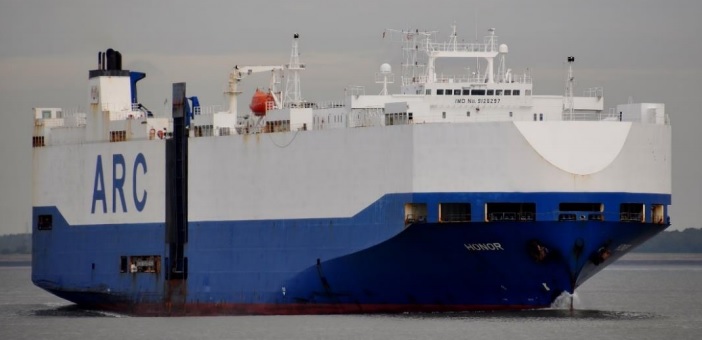The US NTSB issued an investigation report on the fire onboard the US-flagged RORO vehicle carrier ‘Honor’, while en route from Southampton, England, to Baltimore, Maryland, about 55 miles southwest off the Isle of Wight, UK, on 24 February 2017.
The incident
About 0300 local time on 24 February 2017, ‘Honor’ was underway in the English Channel, when a fire broke out in the upper vehicle deck. The fire was extinguished by the crew using the vessel’s CO2 fixed firefighting system. One injury was attributed to the firefighting efforts. The accident resulted in extensive damage, amounting to more than $700,000, to the Honor’s hold as well its cargo of about 5,000 vehicles. No pollution resulted from the accident.
Probable cause The National Transportation Safety Board determines that the probable cause of the fire onboard the vehicle carrier Honor was a fault in the starter motor solenoid in one of the personally owned vehicles being transported in the vessel’s cargo space. NTSB investigators examined the garage deck post-accident when the space was brightly lit and saw cars were stowed close together with multiple lashings. During the fire, thick black smoke reduced visibility to nothing. With no visibility, the way in which the cars were stowed and lashed would have made it virtually impossible for crewmembers to make their way through the space, especially while suited out in bulky firefighting gear and carrying equipment such as portable extinguishers or fully charged hoses. The crew’s timely and effective use of the CO2 fixed firefighting system, along with boundary cooling, likely prevented the spread of the fire and minimized the damage. Fire investigators examined the affected spaces and identified the likely origin to be about frame 40 port side on the garage deck. There was substantial damage to the deck from frames 22 to 46, and several of the vehicles on this deck were destroyed by fire. In addition, several new vehicles (that were being shipped to US car dealerships) located on the deck below (deck 1) sustained fire-related damage. A ventilation duct located at frame 40 port side allowed flaming debris to fall on to the vehicles below. Sixteen of the personally owned vehicles sustained fire damage significant enough to warrant further examination. On May 15, 2017, fire investigators recovered and performed an initial visual examination of the vehicles along with a damaged section of the vessel’s wiring. Evidence of interest removed from several vehicles, along with the damaged wiring, was taken to a third-party laboratory for examination. A joint forensic examination of the evidence was conducted in September 2017. Investigators found that there were three vehicles that were subject to open recalls for fires; however, following an analysis of the debris, none of the recall items were determined to be the cause of the fire, but a fault in the starter motor solenoid in one of the personally owned vehicles in shipment, a scenario which was confirmed by preliminary testing. Further details may be found in the following report:































































